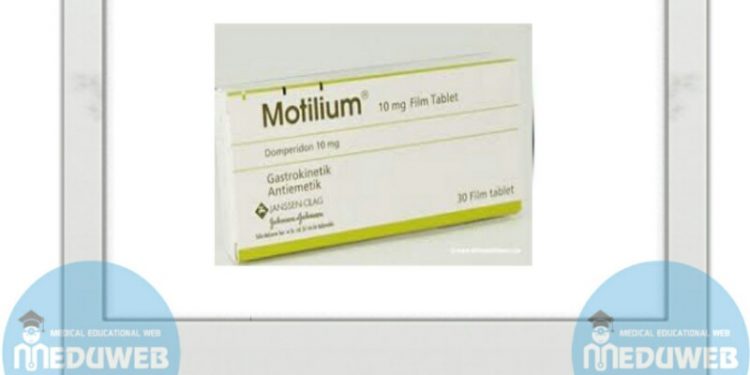Motilium Tablets QUALITATIVE AND QUANTITATIVE COMPOSITION :
One film-coated tablet contains the equivalent of 10 mg domperidone in the form of maleate. The oral suspension contains 1 mg domperidone per ml. For excipients, see List of Excipients.
Motilium Tablets PHARMACEUTICAL FORM :
Oral suspension.

Motilium Tablets Motilium Tablets CLINICAL PARTICULARS :
Therapeutic Indications
1- The dyspeptic symptom complex that is often associated with delayed gastric emptying, gastro-oesophageal reflux and oesophagitis
– epigastric sense of fullness, early satiety, feeling of abdominal distension, upper abdominal pain
– bloating, eructation, flatulence
– nausea and vomiting
– heartbum with or without regurgitations of gastric contents in the mouth.
2- Nausea and vomiting of functional, organic, infectious or dietetic origin or induced by radiotherapy or drug therapy. A specific indication is nausea and vomiting induced by dopamine agonists, as used in Parkinson’s disease (such as L-dopa and bromocriptine).
3- Posology and Method of Administration It is recommended to take oral Motilium before meals. If taken after meals, absorption of the drug is somewhat delayed.
1.Adults and adolescents (over 12 years and weighing 35 kg or more) Tablets
1 to 2 of the 10 mg tablets three to four times per day, with a maximum daily dose of 80 mg. Oral suspension
10 ml to 20 ml (of oral suspension containing domperidone 1 mg per ml) three to four times per day, with a maximum daily dose of 80 ml.
2.1nfants and children
Tablets and Oral suspension 0.25 – 0.5 mg/kg three to four times per day with a maximum daily dose of 2.4 mglkg (but do not exceed 80 mg per day).
Tablets are unsuitable for use in children weighing less than 35 kg.
Motilium Tablets Contraindications :
Motilium is contraindicated in the following situation :
-known hypersensitivity to domperidone or any of the excipients.
– Prolactin-releasing pituitary tumour (prolactinoma).
– Co-adrninistration with oral ketoconazole, erythromycin, or other potent CYP3A4 inhibitors which prolong the QTc interval such as fluconazole, voriconazole, darithromycin, amiodarone, and telithromycin (see Interaction with other medicinal products and other forms of interaction). Motilium should not be used whenever stimulation of gastric motility might be dangerous, e.g. in the presence of gastro-intestinal haemorrhage, mechanical obstruction or perforation.
Motilium Tablets Special Warnings and Special Precautions for Use :
When antacids or antisecretory agents are used concomitantly, they should be taken after meals and not before meals, i.e. they should not be taken simultaneously with Motilium tablets and suspension.
Motilium Tablets Precautions for use:
The film-coated tablets contain lactose and may be unsuitable for patients with lactose intolerance, galactosemia or glucose/galactose malabsorption. The oral suspension contains sorbitol and may be unsuitable for patients with sorbitol intolerance.
Motilium Tablets Use during lactation:
The total amount of domperidone. excreted in human breast milk is expected to be less than 7 g per day at the highest recommended dosing regimen. It is not known whether this is harmful to the newbom. Therefore breast feeding is not recommended for mothers who are taking
Motilium Tablets Use in infants:
Neurological side effects are rare (see Undesirable effects). Since metabolic functions and the blood-brain barrier are not fully developed in the first months of life, the risk of neurological side effects is higher in young children. Therefore, it is recommended that the dose be determined accurately and strictly followed in neonates, infants, toddlers and small children. Overdosing may
cause neurological side effects in children, but other causes should be taken into consideration.
Motilium Tablets Use in liver disorders:
Since domperidone is highly metabolised in the liver, Motilium should be used with caution in patients with hepatic impairment.
Motilium Tablets Use in renal insufficiency:
In patients with severe renal insufficiency (serum creatinine > 6 mg/100 ml, i.e. > 0.6 m molll) the elimination half-life
of domperidone was increased from 7.4 to 20:8 hours,but plasma drug levls were lower than in healthy volunteers. Since very little unchanged drug is excreted via the kidneys, It is unlikely that the dose of a single acute administration needs to be adjusted in patients with renal insufficiency. However, on repeated administration, the dosing frequency should be reduced to once or twice daily, depending on the severity of the impairment, and the dose may need to be reduced. Such patients on prolonged therapy should be reviewed regularly.
Motilium Tablets Interactions with Other Medicinal Products and Other Forms of Interaction :
Antacids and antisecretory drugs should not be given simultaneously. with Motilium tablets and suspension as they lower Its oral bioavailability (see also Special
warnings and special precautions for use). The main metabolic pathway of domperidone is through CYP3A4. In vitro and human data show that the concom- itant use of drugs that significantly inhibit this enzyme may result In Increased plasma levels of domperidone. Examples of potent CYP3A4 inhibitors include:
Azote antlfungals, such as flucoanazol, itraconazole, ketoconazole, and voriconazole. Macrolide antibiotics, such as clarithromycin and erythromycin. HIV protease inhibitors, such as amprenavir, atazanavir, Iosarnprenavlr, indinavir, nelfinavir, ritonavir, and saqumavir
-Calcium antagonists, such as diltiazem and verapamil:
– Amiodarone
– Aprepitant
– Nefazodone
– Telithromycin
(*also prolong the OTc interval; see Contraindications) Separate pharmacokinetic and pharmacodynamic Interaction studies with oral ketoconazole or oral erythromycin in healthy confirmed a marked inhibition of dompendone s CYP3A4 mediated first pass metabolism by these drugs.
With the combination of domperidone 10 mg four times daily and ketoconazole 200 mg twice daily, a mean OTc prolongation of 9.8 msec was seen over the observation period, with changes at individual time points ranging from 1.2 to 17.5 msec., With the combination of domperidone 10mg four times daily and erythromycin 500 mg three times daily, mean OIc ever the observation period was prolonged by 9.9 msec, with changes at individual time points ranging from 1.6 to 14.3 msec. Both the Cmax
and AUC of domperidone at steady state were increased approximately three-fold in each of these interaction studies. (See Contra indications) be contribution of increased plasma concentrations of domperidone to the observed effect on OTc is not known.
In these studies domperidone monotherapy at 10 mg four times daily resulted in increases in mean OTc of 1.6 msec (ketoconazole study) and 2.5 msec (erythromycin study), while ketoconazole monotherapy (200 mg twice daily) and erythromycin monotherapy (500 mg three times daily) led to increases in mean OTc of 3.8 and 4.9 msec, respectively, over the observation period.
In another multiple-dose study in healthy subjects, no significant increases in OTc were noted during steady state treatment with domperidone monotherapy at 40 mg four times daily (total daily dose of 160 mg, which is double the maximum daily dose) at plasma concentrations of domperidone that were at least similar to those found in the combination arms of the interaction studies.
Theoretically, since it has gastro-kinetic effects it could influence the absorption of concomitantly orally administered drugs, particularly those with sustained release or enteric coated formulations. However, In patients already stabilised on digoxin or paracetamol, concomitant administration of dompendone did not Influence the blood levels of these drugs.
It may also be associated with:
– neuroleptics, the action of which it does not potentiate,
– dopaminergic agonists (bromocriptine, L-dopa), whose unwanted peripheral effects such as digestive disorders, nausea and vomiting it suppresses Without counteracting their central properties.
Motilium Tablets Pregnancy and Lactation :
Use during pregnancy
There are limited post-marketing data on the use of domperidone in pregnant women A study in rats has shown reproductive toxicity at a high, maternally toxic dose. The potential risk for humans is unknown. Therefore, it should only be used during pregnancy when justified by the anticipated therapeutic benefit.
Use during lactation
The drug is excreted in breast milk of lactating rats (mostly as metabolites: peak concentration of 40 and 800 mg/ml after oral and i.v. administration of 2.5 mglkg respectively). Domperidone concentrations in breast milk of lactating women are 10 to 50% of the corresponding plasma concentrations and expected not to exceed 10 ng/ml. The total amount of domperidone excreted in human breast milk is expected to be less than 7 g per day at the highest recommended dosing regimen. It is not known whether this is harmful to the newborn. Therefore, breast- feeding is not recommended for mothers who are taking it.
Motilium Tablets Effects on Ability to Drive and Use Machines :
It has no or negligible influence on the ability to drive and use machines.
Motilium Tablets Undesirable Effects :
The adverse drug reactions are ranked by frequency, using the following convention: Ve common (>1110), common (>1/100, < 1/10); uncommo (> 1/1000, < 111QO); rare (>1/10000, < 1/1000), very rare «1/10000), including isolated reports. tmtnune sys!llm disorder
Very rare: anaphylactic reactions including anaphylactic shock; angioneurotic edema; allergic reaction Endocrine disorder
Rare: increased prolactin levels Psychiatric system disorders
Very Rare: agitation; nervousness Nervous system disorders
Very rare: extrapyramidal side effects; convulsion; somenolence headache Gastrointestinal disorders
Rare: gastra-intestinal disorders, including very rare transient intestinal cramps
Skin and subcutaneous tissue disorders Very rare: urticaria; pruritus; rash . Reproductive system and breast disorder.
Rare: galactorrhoea, gynecomastia, amenorrhoea Investigations.
Motilium Tablets Overdose :
Symptoms
Overdose has been reported primarily in infants and children. Symptoms of overdose may include agitation, altered consciousness, convulsion, disorientation, sornnolence and extrapyramidal reactions.
Treatment
There is no specific antidote to domperidone, but in the event of overdose, gastric lavage as well as the administration of activated charcoal may be useful. Close medical supervision and supportive therapy is recommended. Anticholinergic or anti-Parkinson drugs may be helpful in controlling the extrapyramidal reactions.
Motilium Tablets PHARMACOLOGICAL PROPERTIES :
Pharmacodynamic Properties
Domperidone is a dopamine antagonist with anti-emetic properties.Domperidone does not readily cross the blood- brainbarrler, In domperidone users, especially in adults, extrapyramidal side effects are very rare, but domperidone promotes the release of pralactin fram the pituitary. Its antiemetic effect may be due to a combination of peripheral (gastrakinetic) effects and antagonism of dopamine receptors in the chemoreceptor trigger-zone, which lies outside the blood-brain barrier in the area postrema. Animal studies, together with the low concentrations found in the brain, indicate a predominantly peripheral effect of domperidone on dopamine receptors. Studies in man have shown oral domperidone to increase lower oesophageal pressure, improve antroduodenal motility and accelerate gastric emptying. There is no
effect on gastric secretion.
Motilium Tablets MANUFACTURED BY :
Minapharm -Egypt under license 01 Janssen Pharma ceutica Beerse-Belgium


